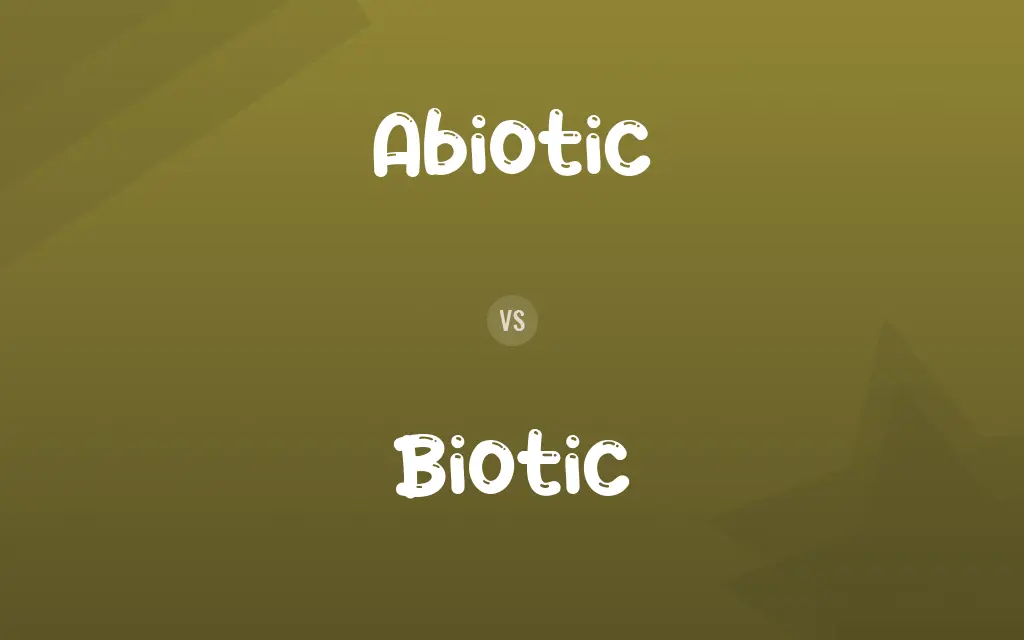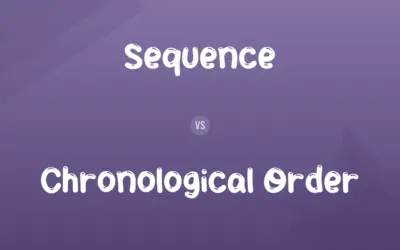Abiotic vs. Biotic: Difference and Comparison
Edited by Muazma Batool — By Muneeza Rehman — Published on April 28, 2024
Abiotic refers to non-living factors in an ecosystem, while biotic pertains to living organisms and their interactions.

Difference Between Abiotic and Biotic
In the realm of ecology and environmental science, the terms abiotic and biotic hold significant importance. Abiotic components represent the non-living elements in an ecosystem, such as water, sunlight, temperature, and soil. These factors play a critical role in determining the conditions in which living organisms can survive, grow, and reproduce. For instance, the presence and quality of water, along with sunlight, are abiotic factors crucial for photosynthesis in plants.
Muneeza Rehman
Apr 28, 2024
Biotic components, on the other hand, refer to all the living entities within an ecosystem. This includes plants, animals, fungi, bacteria, and other organisms. These biotic elements not only interact with each other but also with the abiotic components, resulting in a dynamic and intricate web of relationships. The predation of rabbits by foxes or the mutualistic relationship between bees and flowers are examples of biotic interactions.
Muazma Batool
Apr 28, 2024
While abiotic factors set the stage, so to speak, the biotic factors perform on it. The abiotic conditions of an environment can dictate which organisms can inhabit that space. For instance, only certain types of plants and animals can thrive in desert conditions, characterized by limited water and extreme temperatures. Conversely, biotic factors, through processes like competition and predation, influence population dynamics and species distribution within those abiotic confines.
Muneeza Rehman
Apr 28, 2024
In essence, understanding the distinction between abiotic and biotic is fundamental to grasping the functioning of ecosystems. Both play interdependent roles, with abiotic factors shaping the environment and biotic factors bringing it to life through complex interactions.
Jonathan
Apr 28, 2024
Abiotic vs. Biotic Comparison Chart
Influences
Determines which organisms can live
Affects population dynamics and species spread
Muneeza Rehman
Apr 28, 2024
Interaction
Interacts with biotic factors
Interacts with both biotic and abiotic factors
Lucas
Apr 28, 2024
Abiotic vs. Biotic Definitions
◉Abiotic
Pertaining to non-living elements in an environment.
Sunlight is an abiotic factor essential for plant growth.
Muazma Batool
Sep 24, 2023
◉Biotic
Pertaining to life and living processes in an environment.
Biotic factors like herbivory can influence plant population sizes.
Jonathan
Sep 24, 2023
◉Abiotic
Environmental components devoid of life.
Wind, as an abiotic factor, plays a role in seed dispersal.
Olivia
Sep 24, 2023
◉Biotic
Anything associated with life or living organisms.
Biotic interactions like competition can shape community structures.
Muneeza Rehman
Sep 24, 2023
◉Abiotic
Physical and chemical components outside of living organisms.
Soil composition is an abiotic factor that affects plant health.
Olivia
Sep 24, 2023
◉Biotic
Relating to living organisms and their interactions.
Forests are filled with biotic interactions, such as predation and symbiosis.
Lucas
Sep 24, 2023
◉Abiotic
Factors that don't have life but influence living systems.
The abiotic factor of temperature determines which plants can grow in certain regions.
William
Sep 24, 2023
◉Biotic
Living elements in an ecological context.
Pollination is a crucial biotic process for many plants.
Elijah
Sep 24, 2023
◉Abiotic
Elements not derived from living organisms.
Rock formations are abiotic structures that can influence ecosystem layouts.
Muneeza Rehman
Sep 24, 2023
◉Biotic
Components derived from living entities.
The biotic elements of a pond include fish, algae, and aquatic plants.
Muazma Batool
Sep 24, 2023
◉Abiotic
Nonliving
The abiotic factors of the environment include light, temperature, and atmospheric gases.
Muneeza Rehman
Sep 24, 2023
◉Abiotic
Nonliving, inanimate, characterised by the absence of life; of inorganic matter.
Muneeza Rehman
Sep 24, 2023
◉Abiotic
Tending to inhibit or destroy life; antibiotic; incompatible with life.
Muneeza Rehman
Sep 24, 2023
◉Biotic
(biology) Of, pertaining to, or produced by life or living organisms
Muneeza Rehman
Sep 24, 2023
◉Biotic
A nutritional substance that improves the health of gastrointestinal microorganisms, especially one that occurs naturally.
Muneeza Rehman
Sep 24, 2023
◉Biotic
A simple organic organism that is more complex than an organic molecule but simpler than a plant or animal.
Muneeza Rehman
Sep 24, 2023
Abiotic vs. Biotic Frequently Asked Questions
Are animals and plants biotic?
Yes, animals and plants are considered biotic components.
Muazma Batool
Apr 28, 2024
What does abiotic encompass?
Abiotic encompasses the non-living components of an ecosystem.
Muneeza Rehman
Apr 28, 2024
What's a primary difference between abiotic and biotic?
Abiotic refers to non-living factors, while biotic pertains to living organisms.
Muneeza Rehman
Apr 28, 2024
How do abiotic factors affect plant growth?
Abiotic factors like soil quality, water, and sunlight directly influence plant growth and health.
Leo
Apr 28, 2024
Can biotic components change abiotic ones?
Yes, biotic components like plants can alter abiotic factors by processes like soil stabilization.
Muneeza Rehman
Apr 28, 2024
Can abiotic factors influence biotic interactions?
Yes, abiotic factors can shape the conditions in which biotic interactions occur.
Muneeza Rehman
Apr 28, 2024
Is bacteria a biotic component?
Yes, bacteria are considered a biotic component.
Muneeza Rehman
Apr 28, 2024
Which has a more direct role in photosynthesis, abiotic or biotic?
Both play roles; the plant (biotic) conducts photosynthesis using sunlight (abiotic).
Muneeza Rehman
Apr 28, 2024
Are human-made structures considered abiotic?
Yes, human-made structures are non-living and thus are abiotic.
Jonathan
Apr 28, 2024
How do biotic elements interact?
Biotic elements interact through processes like predation, competition, and symbiosis.
Leo
Apr 28, 2024
Content Creators
Written by
Muneeza RehmanAt Comparisons.wiki, Muneeza skillfully navigates the vast sea of information, ensuring clarity and accuracy as the lead content editor. With a keen eye for detail, she curates every comparison to enlighten and engage readers.
Edited by
Muazma BatoolAs a content editor, Muazma Batool is not just a grammar guru but a creative mastermind who breathes life into every word. With an eagle eye for detail and a passion for storytelling, she transforms bland text into engaging content that captivates audiences and drives results.































